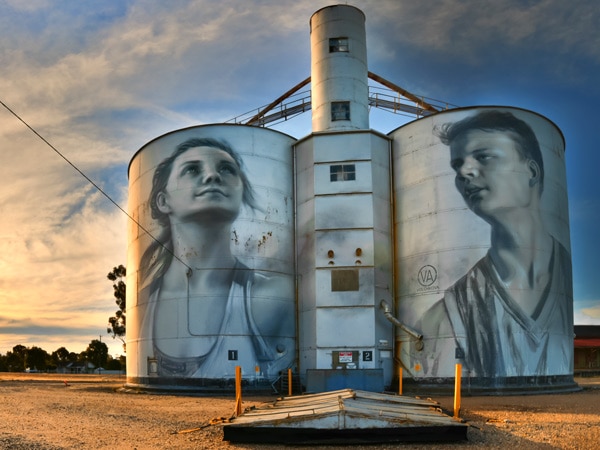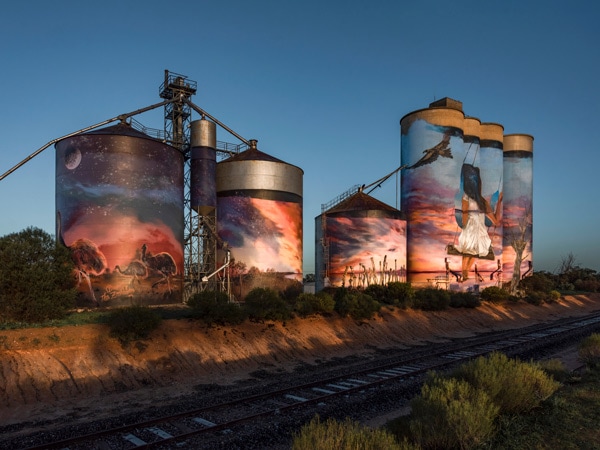May 16, 2022
![]() 10 mins Read
10 mins Read
Stretching over 200 kilometres, Victoria’s Silo Art Trail is Australia’s largest outdoor gallery (and one of 100 Amazing Road Trips).
Conceived after the success of the first silo artwork in Brim in 2016, the trail recognises and celebrates the Wimmera Mallee region through a series of large-scale mural portraits that have given new life to the 80–90-year-old grain silos.
The project saw a team of renowned artists from Australia and across the world visit the region, meet the locals and transform each grain silo into an epic work of art; each one telling a unique story about the host town.
Located about three hours from Melbourne, Rupanyup is the ideal first stop for your Silo Art Trail road trip.
Rupanyup’s silo art is the work of Russian mural artist, Julia Volchkova, who turned her attention to the town’s youth and their great love of team sport. Capturing the spirit of community and providing an accurate insight into rural youth culture, the work features the faces of Rupanyup residents and local sporting team members, Ebony Baker and Jordan Weidemann, who are dressed in their sports attire (netball and AFL, respectively).

Julia Volchkova depicted Rupanyup locals Ebony Baker and Jordan Weidemann on the silos. (Image: Visit Victoria/Anne Morely)
As a side project of the Silo Art Trail, Melbourne street artist Georgia Goodie painted two murals in Rupanyup, each one depicting firefighters. The first mural is at a house that was damaged by fire in September 2016, while the other adorns the town’s old shire office building.

Head to the Rupanyup old shire office building to see Melbourne street artist Georgia Goodie’s firefighter murals. (Image: Visit Victoria/Anne Morely)
The Shack is a rustic and homely rural retreat. The two-bedroom cottage offers panoramic views of farm paddocks, dams, gum trees and the Grampians, the perfect place to rest after a day of exploring.
Melbourne-based artist, Adnate found inspiration for his mural on the Sheep Hills silos in 2016 when he developed a friendship with the Barengi Gadjin Land Council in north-west Victoria.
Adnate depicted Wergaia Elder, Uncle Ron Marks, and Wotjobaluk Elder, Aunty Regina Hood, alongside two young children, Savannah Marks and Curtly McDonald to celebrate the richness of the area’s Indigenous culture.
The night sky represents elements of local dreaming and the overall image signifies the important exchange of wisdom, knowledge and customs from Elders to the next generation.
Spending four weeks with the community in late 2016 to conceive and complete the mural, Adnate sought to shine a spotlight on the area’s young Indigenous people and highlight the strong ancestral connection they share with their Elders.

Adnate shines light on the strong ancestral connection young Indigenous people share with their Elders. (Image: Visit Victoria/Anne Morely)
Artist Geoffrey Carran was heavily inspired by the birdlife in West Wimmera Shire when creating the Goroke silo art. The word Goroke is the local Aboriginal word for magpie, so the native bird was a natural choice. Geoffrey then expanded the idea to include other native birds, including a kookaburra and galah.

The word Goroke is the local Aboriginal word for magpie. (Image: Visit Victoria/Anne Morely)
The artwork was painted by David Lee Pereira and pays tribute to the nearby Little Desert and its diverse flora and fauna. It is home to more than 600 species of native plants, 220 species of birds and 60 native mammals and reptiles.
The design features the Australian Hobby bird, which is smaller than other falcons, and is one of six Australian members of the family ‘Falconidae’. To the left of the bird is the plains sun orchid, with the salmon/pink sun orchid on the right.

The Australian Hobby bird is smaller than other falcons. (Image: Visit Victoria/Anne Morely)
Guido van Helten’s iconic Brim mural was the first silo artwork to appear in Victoria, and after gaining widespread local and international attention, its success shone a spotlight on the Wimmera Mallee region and inspired the establishment of the Silo Art Trail.
Completed in early 2016 van Helten’s mural depicts a multi-generational quartet of female and male farmers. Rendered across the four silos, van Helten’s subjects bear expressions that exemplify the strength and resilience of the local farming community.
The figures are both central and peripheral, present and absent, and the work explores shifting notions of community identity at a time when rural populations face both immense economic pressure and the tangible consequences of climate change.

Guido van Helten’s Brim mural was the first silo artwork to appear in Victoria. (Image: Visit Victoria/Anne Morely)
Nine kilometres north of Brim on the Henty Highway is the Netting Fence, constructed in 1885 to stop rabbits invading the Mallee from the south and to keep the dingos to the north. The fence is also the division between the Wimmera and the Mallee regions.
Brim has a stunning free campsite, which can be powered (or not!) called Reddas Park Camping Area.
Before commencing work in Rosebery, Melbourne artist, Kaff-eine spent time in the Mallee assisting fellow artist Rone on his Lascelles silo project. Kaff-eine’s artwork depicts themes that she says embody the region’s past, present and future.
The silo on the left captures the grit, tenacity and character of the region’s young female farmers, who regularly face drought, fires and other hardships living and working in the Mallee.
The silo on the right portrays a quiet moment between man and horse, who are relaxed and facing downward, indicating their mutual trust, love and genuine connection.

Kaff-eine’s artwork depicts themes that embody the region’s past, present and future. (Image: Visit Victoria/Anne Morely)
Ten kilometres north of Rainbow lies the quirky, colourful and more modern take on Silo Art at Albacutya Silo.
Melbourne artist Kitt Bennett was inspired to, “create an artwork that tells a story of growing up in the country as a youth. I have fond memories of exploring the bush and looking for yabbies under rocks in creeks with my parents. Reflecting on this weird and wonderful time as an adult is something that brings me a lot of happiness.”

The Albacutya Silo by Kitt Bennett is a more modern take on silo art. (Image: Visit Victoria/Anne Morely)
To prepare for his Patchewollock mural, Brisbane artist, Fintan Magee booked a room at the local pub to immerse himself in the community and get to know its people. When he met local sheep and grain farmer, Nick “Noodle” Hulland, Magee knew he had found his muse.
The rugged, lanky local exemplified the no-nonsense, hardworking spirit of the region. Perhaps more importantly though, Noodle had just the right height and leanness to neatly fit onto the narrow, 35-metre-high canvas of the twin silos. Hulland’s solemn expression, sun-bleached hair and squinting gaze speak to the harshness of the environment and the challenges of life in the Wimmera Mallee.

Brisbane artist, Fintan Magee met his silo art subject at the local pub. (Image: Visit Victoria/Anne Morely)
Lake Albacutya is one of a series of terminal lakes on the Wimmera River, which form the largest land-locked drainage system in Victoria.
The Big Mallee Fowl, constructed almost entirely from painted corrugated iron, is one of the most obscure of Australia’s Big Things. Make sure you stop by when you’re in Patchewollock!

The Big Mallee Fowl is a lesser-known “Big Thing” in Australia. (Image: Visit Victoria/Anne Morely)
Just 20 minutes out of Patchewollock is Pine Plains Lodge. With glorious sunrises, lingering sunsets, clear night skies and stars so close you can almost touch them, it is the perfect place to cosy up next to the fire after a big day sightseeing.
In order to capture the true essence of Lascelles, Melbourne-based artist, Rone knew that he had to learn about the town from those who were deeply connected to it. He depicts local farming couple Geoff and Merrilyn Horman, part of a family that has lived and farmed in the area for four generations.
Rone says that he wanted the mural to portray his subjects as wise and knowing, nurturing the town’s future with their vast farming experience and longstanding connection to the area.

The mural portrays Geoff and Merrilyn Horman as wise and knowing. (Image: Visit Victoria/Anne Morely)
Joel Fergie and Travis Vinson painted the silo artwork at Sea Lake as a celebration of the still and silence found in outback Victoria, and the associated feelings of wholeness and freedom. The young girl, swinging from a Mallee Eucalyptus, looks over Lake Tyrrell and reflects on her Indigenous heritage.
The Indigenous name ‘Tyrille’ means ‘space opening to the sky’ as the colours of dusk and dawn are reflected in the shallow saline bowl. The Boorong People were known to have more knowledge of astronomy than any other tribe, and their stories are rich in culture and connection to the lake. The artwork aims to connect and bring the viewer closer to some of the relatively ordinary and overlooked elements of the outback landscape and allows viewers to see these elements from a new perspective.

The Boorong People were known to have more knowledge of astronomy than any other tribe, and their stories are rich in culture and connection to Lake Tyrrell. (Image: Visit Victoria/Anne Morely)
A visit to Lake Tyrrell, Victoria’s largest salt lake, is a must while in Sea Lake. You’ll get a once in a lifetime insta pic, plus the 120,000-year-old lake is regarded as one of the best places in Australia for stargazing, with the dark and endless skies providing the perfect environment.

Lake Tyrrell is the ultimate stargazing spot. (Image: Visit Victoria/Anne Morely)
Sea Lake has a range of different stays to suit your needs, whether camping is your vibe or you’d prefer to relax in a hotel.
Artist Sam Bates (Smug) painted the Nullawil silo of a kelpie sheepdog and a farmer on the concrete canvas. The soft-coated black and tan Kelpie was depicted with a sheen on his coat, a shiny black nose, a spark in his brown toned eyes and fine grey whiskers above his semi drooped mouth.
As a “nod” to the history of Nullawil the registration disc has a “galah” and “stick” engraved on it. The name of the town is derived from two Aboriginal words, “Nulla” which means killing stick, and “Wil” derived from the term “willock” meaning Galah.
After visiting Nullawil, it’s back home to Melbourne!

The name of the town is derived from two Aboriginal words, “Nulla” which means killing stick, and “Wil” derived from the term “willock” meaning Galah. (Image: Visit Victoria/Anne Morely)
For the  best travel inspiration delivered straight to your door.
best travel inspiration delivered straight to your door.
Any chance of getting a bus company to do a bus tour of the Silo Art Trail you have featured in this email?
My sister and I managed to do most of the Victorian Silo Trail last year and it was fabulous. Such a delight to travel from one small country town to another, something lost in ravel with all the highways that bypass smaller towns. I recommend the Trail to everyone.
An intriguing article which does the work for you. A perfect getaway for me with my teardrop camper.